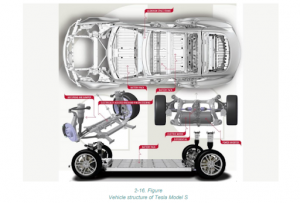Lesson 3: Examples of Electric Vehicles
In this lesson, we will explore two prominent examples of Battery Electric Vehicles (BEVs), the BMW i3, and the Tesla Model S, to understand their features, technology, and impact on the electric vehicle market.
- BMW i3
- The BMW i3 is a modern electric car that has been in production since 2013.
- It is known for its eco-friendly operation and innovative use of materials to reduce vehicle weight.
- The manufacturing process at the Leipzig factory in Germany emphasizes sustainability with reduced water and energy consumption.
1.1 Key Features of BMW i3
- Lightweight Construction: The BMW i3 incorporates modern materials and manufacturing techniques to maintain a low vehicle weight of 1195 kg.
- Carbon Fiber Body: The vehicle features a carbon fiber body, an aluminum chassis for battery protection, and a rear-mounted drivetrain.
- Battery Placement: Lithium-ion batteries with a nominal voltage of 360 V and a capacity of 22 kWh are positioned in the vehicle’s floor, lowering the center of gravity.
- Electric Motor: The i3 is powered by a synchronous alternating current motor with a permanent magnet, providing a maximum power of 125 kW and 250 Nm of torque.
- Performance: The i3 accelerates from 0 to 100 km/h in 7.2 seconds, with a top speed of 150 km/h. It offers an average range of 130 to 160 km per charge, with the potential for up to 200 km in energy-efficient mode.
- Zero Emissions: With zero exhaust emissions, the i3 demonstrates eco-friendly driving with an average electricity consumption of 12.9 kWh/100 km.
1.2 Hybrid Variant
- Some versions of the BMW i3 include a two-cylinder internal combustion engine that acts as a generator to recharge the battery, extending the vehicle’s range.

- Tesla Model S
- Tesla Model S is a luxury sports electric vehicle that debuted in 2009 and has since seen multiple iterations and battery energy options.
- Its aerodynamic design, low air resistance coefficient (cx = 0.24), and use of aluminum in the body contribute to its sporty appearance and performance.
2.1 Battery Options and Performance
- Tesla Model S offers a range of battery options, ranging from 40 kWh to 100 kWh.
- Power output varies from 285 kW to 586 kW, with the P100D variant reaching a maximum torque of 931 Nm and accelerating from 0 to 100 km/h in just 2.4 seconds.
2.2 Drivetrain Structure
- The drivetrain is a compact unit consisting of an electric motor, inverter, and a single-stage reduction gear with differential.
- The drive is achieved through a three-phase induction motor.
- The lithium-ion battery, comprising over 7000 interconnected cylindrical cells, is located in the vehicle’s floor.

Conclusion
- The BMW i3 and Tesla Model S exemplify the advancements in Battery Electric Vehicle (BEV) technology.
- Both vehicles offer sustainable and efficient driving solutions while catering to different segments of the market.
- Understanding these examples sheds light on the diversity and potential of electric vehicles in modern transportation.
In this lesson, you’ve explored two remarkable Battery Electric Vehicles (BEVs), the BMW i3 and the Tesla Model S. These vehicles showcase the innovative technology and environmental benefits of electric mobility while catering to diverse consumer needs.